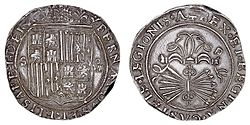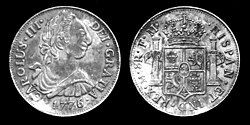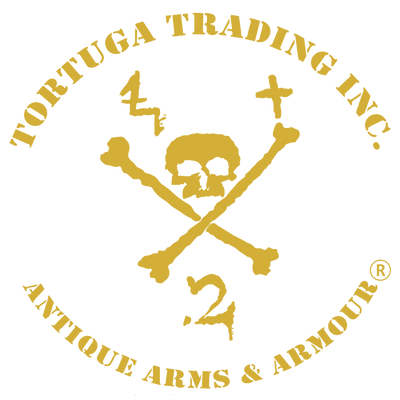TREASURE !!! Spanish New World Silver 8 Reales COB, MEXICO, PHILIP V
TREASURE !!!
A very nice example, Spanish New World Silver 8 Reales COB.
Mint; oM, Mexico City
Date; nv.
Reign; PHILIP V
ASSAYER; Faint top portion of "D"
Grade- I
Weight; 26.5 grams.
Note; If this coin was made during the reign of Luis I (1724), it would be very rare !
Additional Notes: These coins were the most desirable currency of the world for over 300 years from the 1500's - 19th century and were legal tender in the United States until the Act of 1857.
TTI-546621
Spanish dollar
|
||||||
|
||||||
|
||||||
|
||||||
|
||||||
|
||||||
The Spanish dollar, also known as the piece of eight (in Spanish: Real de a ocho, Dólar, Peso duro, Peso fuerte or Peso), is a silver coin of approximately 38 mm (1.5 in) diameter worth eight Spanish reales. It was minted in the Spanish Empire following a monetary reform in 1497. It was widely used as the first international currency because of its uniformity in standard and milling characteristics. Some countries countersigned the Spanish dollar so it could be used as their local currency.[1]
The Spanish dollar was the coin upon which the original United States dollar was based, and it remained legal tender in the United States until the Coinage Act of 1857. Because it was widely used in Europe, the Americas, and the Far East, it became the first world currency by the late 18th century.[2][3][4] Aside from the U.S. dollar, several other currencies, such as the Canadian dollar, the Japanese yen, the Chinese yuan, the Philippine peso, and several currencies in the rest of the Americas, were initially based on the Spanish dollar and other 8-real coins.[5] Diverse theories link the origin of the "$" symbol to the columns and stripes that appear on one side of the Spanish dollar.[6]
The term peso was used in Spanish to refer to this denomination, and it became the basis for many of the currencies in the former Spanish colonies, including the Argentine, Bolivian, Chilean, Colombian, Costa Rican, Cuban, Dominican, Ecuadorian, Guatemalan, Honduran, Mexican, Nicaraguan, Paraguayan, Philippine, Puerto Rican, Peruvian, Salvadoran, Uruguayan, and Venezuelan pesos. Of these, "peso" remains the name of the official currency in Argentina, Chile, Colombia, Cuba, Dominican Republic, Mexico, Philippines, and Uruguay.
Millions of Spanish dollars were minted over the course of several centuries. They were among the most widely circulating coins of the colonial period in the Americas, and were still in use in North America and in South-East.
TTI-546621














